Causes and treatment of cucumber anthracnose: the most effective methods of fighting for crop health
If you notice yellow spots on the leaves of cucumbers, sound the alarm. One of the diseases with this symptom is cucumber anthracnose. Without timely treatment, it is able to completely destroy the crop.
About the symptoms, causes of the appearance, treatment and prevention of anthracnose on cucumbers - in our article.
The content of the article
What is this disease
Cucumber anthracnose (see photo) is a fungal disease that affects the entire bush, for sparing and fruit. Gardeners often call this disease by its middle name - copperhead. The causative agent of anthracnose is a fungal bacterium of the genus Colletotrichum.
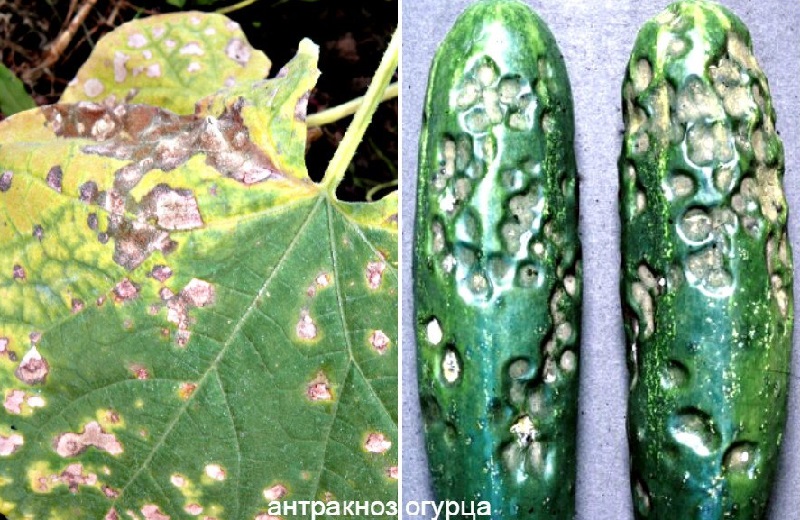
Disease found everywhere - both in open and closed ground... Cucumbers growing in a greenhouse are more susceptible to anthracnose. But even in the garden bed, he can easily attack the culture.
The disease follows the cucumber at all stages of its development.... The first symptoms are sometimes noticeable even on seedlings. In addition to cucumbers, tomatoes, raspberries, strawberries, currants, grapes, cherries and other crops are susceptible to anthracnose.
Anthracnose symptoms
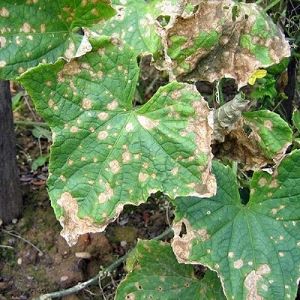 Anthracnose manifests itself on all aboveground plant organs (both young and adult), especially strongly affects fruits. On seedlings, the disease manifests itself as depressed brown spots in the area of the root collar. Symptoms in mature plants are easier to recognize.
Anthracnose manifests itself on all aboveground plant organs (both young and adult), especially strongly affects fruits. On seedlings, the disease manifests itself as depressed brown spots in the area of the root collar. Symptoms in mature plants are easier to recognize.
Leaves
At first, pale green spots with a diameter of about 3 mm appear, which later merge into large ones - up to 4 cm. Over time, the spots become copper-brown, the leaf turns brown, becomes brittle, dries up in dry weather or rots at high humidity. Often, holes form in the affected areas.
Fruit
On the greens, depressed oblong spots appear in the form of ulcers of light brown color and of different sizes. The mycelium of the fungus penetrates 3-4 mm into the fruit. Cucumbers become bitter, later darken and rot. Such fruits are not suitable for sale or consumption.
Stem
Covered with weeping, elongated, depressed spots of brown-yellow color. In the affected areas, the stem becomes thinner and cracked, the plant dies.
With high humidity, the affected areas of the plant are covered with a pink bloom - these are fungal spores. Then black dots appear - sclerotia.
Danger and harm done
Anthracnose spreads rapidly and affects all plant organs... The disease leads to a decrease in the quality and quantity of the crop. Plants can die if the fungus is allowed to spread. Fruits lose the organic acids and sugar they contain, lose their taste - they become bitter and rot.
The fungus is ubiquitous, but the greatest damage it inflicts on cucumbers in film greenhouses and open ground. Typically, yield losses from anthracnose range from 6% to 48%, in some years they can reach 55%.
Causes of the disease
Anthracnose is spread by wind, rain and insects. Often, contaminated seeds and plant debris are sources of it.... The fungus can also persist on the inner surfaces of the greenhouse in which the diseased plant grew.
Also conidia mushroom spread from diseased plants to healthy during watering or direct contact. Weakened plants in a film greenhouse or open ground are most susceptible to anthracnose.
The fungus develops in conditions of high humidity (90%) and high temperatures (22-27 ° C)... The soil in which anthracnose develops has a high level of acidity, deficiency of potassium and phosphorus. The fungus lives and develops at temperatures from 4 to 30 ° C. But with air humidity below 60%, the disease does not manifest itself in any way.
About other diseases of cucumbers
Causes and treatment of mosaic on cucumbers
Cucumber treatment
To keep the plant alive and reap a healthy and large harvest from it, you can't ignore anthracnose... The sooner you notice the disease and start to fight it, the less losses it will cost you.
There are different methods of dealing with anthracnose on cucumbers.: these are agrotechnical methods, and folk remedies, and chemicals. The latter, of course, are considered the most effective, but also the most unsafe. But, unfortunately, it will not be possible to cope with anthracnose by agrotechnical methods alone.
Agrotechnical techniques
Agrotechnical methods more suitable for preventing disease and preventing its spread on healthy plants. These are crop rotation, removal of plant residues, disinfection of the greenhouse, etc.
Before planting seedlings Examine each seedling carefully for signs of anthracnose. Remove diseased sprouts immediately.
To keep the disease from spreading among mature plants, the infected shrub should also be carefully removed from the garden or greenhouse and burned.
If you notice signs of illness at a very early stage, its development can be easily stopped by reducing the air humidity to 60%. But only stop, not cure.
The only effective agricultural technique against anthracnose, capable of destroying the mushroom - root watering with 1% Bordeaux liquid. First, water the soil around the plant with plenty of water and then a solution (1 liter per bush). It should hit the root and base of the stem. Repeat the treatment once every 2-3 days until the fungus is completely destroyed.
Folk remedies
Folk remedies used to disinfect seeds before planting... First, the material is thermally disinfected. The seeds are placed in hot (about 60 ° C) water for 5-6 hours, and then in cold water for 2-3 minutes.
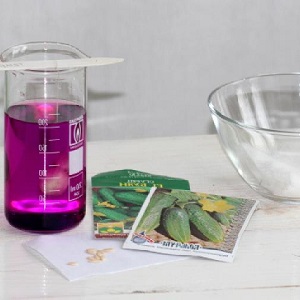 The second method is sterilization in a solution of potassium permanganate... 1 teaspoon of powder is dissolved in 600 ml of water and cucumber seeds are placed there for 20 minutes. After the procedure, the planting material is washed with water.
The second method is sterilization in a solution of potassium permanganate... 1 teaspoon of powder is dissolved in 600 ml of water and cucumber seeds are placed there for 20 minutes. After the procedure, the planting material is washed with water.
The third method is the use of natural fungicides... These include mustard, aloe, alcoholic herbal infusions:
- In a 2% aqueous solution of mustard seeds are placed for 6 hours, in alcoholic herbal tinctures - for 1 hour.
- Aloe leaves are put in the refrigerator for 5-6 days, then juice is squeezed out of them, diluted with water 1: 1 and seeds are placed in it for a day.
For reference.Treatment of anthracnose in adult plants with folk remedies is recognized by many gardeners as ineffective.
But among opponents of chemicals, the method is popular, which is considered less harmful to the culture. First, the infected plant is treated with a 5-7% solution of copper sulfate, after which honey, lime and coal are applied to the affected areas of the bush.
Also considered harmless is root watering with Bordeaux liquid, which was written above.
Chemicals
To combat anthracnose at the earliest stagewhen it is in the infected seed, the TMTD dressing agent is used. The procedure is carried out 2-5 days before planting at the rate of approximately 4.5 g of the drug per 2 kg of seeds.
Also before planting, the seeds are soaked in a solution "Immunocytophyta" or "Thiram" (TMTD).
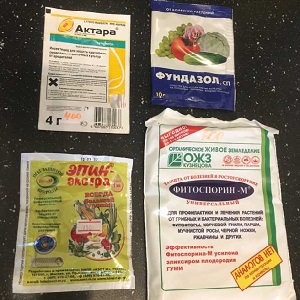 Anthracnose in adult cucumbers is treated with fungicides. The most effective of them are:
Anthracnose in adult cucumbers is treated with fungicides. The most effective of them are:
- Fitosporin. Powder: 10 g per 5 l of water; 3 sprays at intervals of 10-15 days. Paste: 4 drops in 200 ml of water. Liquid - 10 drops per 20 ml of water.
- "Previkur".1.5 ml per 1 liter of water.
- Abiga Peak. Dissolve 40-50 g in a liter of water, then add water to 10 liters. Process 3-4 times per season at intervals of 20-30 days.
- "Quadris". 5 ml for 10 liters of water. Up to 3 treatments.
- "Tiovit Jet". 30–80 g per 10 liters of water.
- Fundazol. Used for watering, spraying or dressing seeds. 1 g of the drug per 1 liter of water. No more than 2 sprays per season. Seeds are pickled one month before planting.
Important! Read the instructions carefully. After processing cucumbers with chemistry, the harvest is allowed to be harvested only after 5-30 days (depending on the preparation).
Always take precautions when handling chemicals... Treat with protective clothing, respirator, goggles, gloves. After the procedure, it is advisable to discard gloves, wash your eyes, hands, face with soap, rinse your mouth.
Working solutions are not subject to storage... Be careful: some preparations repel insects, including bees, so you cannot use them during the flowering period of cucumbers.
Useful about crop pests:
Features of treatment in a greenhouse
Greenhouse plants are most susceptible to anthracnose contamination:
- Firstly, greenhouse conditions are more comfortable for the development of fungus: moderately high temperature combined with increased humidity levels.
- Secondly, the fungus often remains on the inner surfaces of the greenhouse, systematically infecting the plants in it. Therefore, be sure to disinfect the greenhouse after harvest and before the new planting season.
- Thirdly, in the greenhouse, the plants are located close to each other, which facilitates and accelerates the spread of the fungus.
The convenience of treating cucumbers in a greenhouse is that you can adjust the humidity level yourself. When the first signs of fungus are found, reduce this figure to 60% to stop the development of the disease. Then treat the plants with fungicides according to the scheme.

Outdoor treatment
In the beds in the garden, infection most often occurs through seeds, wind and insects... Contaminated soil and plant debris can also cause anthracnose in outdoor cucumbers.
Of the listed methods for beds, root watering and treatment with 1% Bordeaux liquid are best suited... Spraying with drugs is carried out in the early morning (before 10:00) or in the evening (after 18:00), when the plants do not get sunburn. The weather should be dry and calm.
For a longer effect, check the weather forecast for the coming days. If there is no rain, feel free to spray, then the treatment solution will not wash off ahead of time.
Preventive measures
Anthracnose spreads at a high speed, so instead of spending energy fighting it, it is better to pay more attention to prevention. Inspect plants regularly for signs of disease, to notice it early on:
- Plant seeds only from healthy plants, buy them from trusted producers. Choose varieties that are resistant to anthracnose.
- Before planting, calibrate the seeds, use dressing agents and fungicides to disinfect the planting material.
- Do not ignore the rules of crop rotation: cucumbers are planted in the same place with an interval of 4 years.
- Dig up and burn diseased plants. At the end of the season, burn the cucumber tops, dig deep into the soil, and remove all plant debris. In the greenhouse, remove the top 10 cm of soil, fill in a new one.
- Disinfect the greenhouse after harvest and before planting.
- Add potash and phosphorus fertilizers to the soil, feed with organic matter and biological products.
- Disinfect soil, disinfect garden tools.
- Watch out for moisture that accumulates in plastic greenhouses. Ventilate the greenhouse.Plant the plants at a considerable distance from each other so that the fungus cannot move from one to the other.
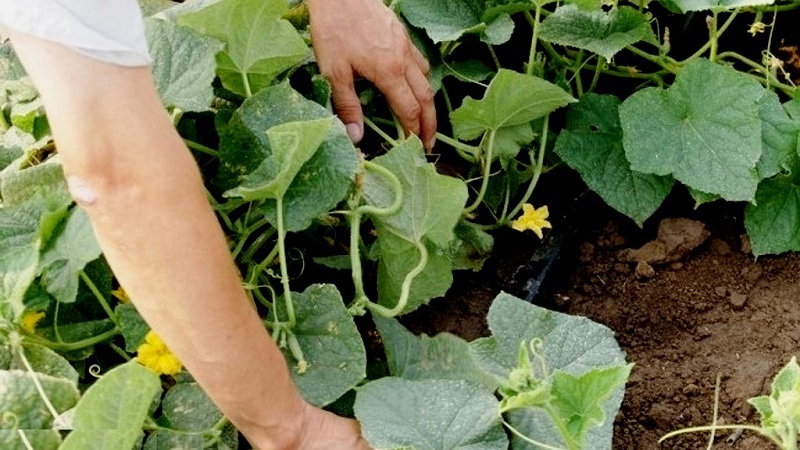
Useful Tips
Galina Kizima, a renowned gardener and author of books, advises spray the plants in the greenhouse with a solution of potassium permanganate, and then pollinate the leaves with mustard powder or ash.
Use 1 tsp Bordeaux mixture. for 5 liters of water... This is one of the most effective ways to treat cucumber anthracnose outdoors.
Systematic inspection of plants and removal of leaves with signs of infection (primarily from the bottom of the bushes) will not only stop the development of the disease, but also improve air circulation in the garden.
Do not neglect chemicals in the fight against fungus. This is the only effective treatment for anthracnose.
Conclusion
Anthracnose is a common fungal disease among vegetables, especially cucumbers. Due to the large number of distribution methods, it is almost impossible to protect plants from it. Do not be lazy to carry out prevention, follow the rules of crop rotation, pay special attention to the disinfection of seeds, soil, greenhouses and tools. Do not hesitate with treatment. The sooner you notice symptoms and start getting rid of anthracnose from cucumbers, the less plants and crops you will lose.
Carefully read the instructions for the drugs, follow the precautions and rules of use. Remember that after treatment with chemicals, the crop is allowed to be harvested in 5-30 days.